Friday 17 February, 2006, 13:34 - Spectrum Management
Ofcom recently organised a seminar concerning the forthcoming auction of a chunk of UHF spectrum covering the UK. The spectrum concerned is 412 - 414 MHz paired with 422 - 424 MHz which was previously the haunt of the UK Ministry of Defence (MoD). The MoD have now (largely) vacated this spectrum and Ofcom has decided that the best use for it is to sell it to the highest bidder along with the rights for the winning bidder to sell it on to whoever they fancy.Four blocks (the inventively named A, B, C and D) of 2 times 500 kHz are being offered, and bidders can bid for one or more of these blocks. The winning bidder(s) will be decided by a complex mathematical calculation to determine which combination of bids yields the maximum revenue to Ofcom.
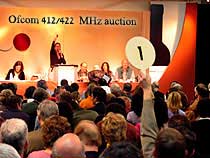 By way of an example, let's assume there are four bidders: Eric, Simon, Abby and Tamara. Eric offers GBP300,000 for all four blocks of spectrum. Simon wants 3 blocks and offers GBP200,000 for blocks A, B and C but is not interested in D. Abby wants only 1 block and offers GBP150,000 for any of them - A, B, C or D. Tamara wants two contiguous blocks and offers GBP250,000 for A&B, B&C or C&D. How do we decide the winner? Well in this situation, the maximum revenue that can be generated is if Simon gets blocks A, B and C and Tamara gets block D, yielding revenue of GBP350,000 for Ofcom. If, however, Tamara had only bid GBP100,000 for any block, there would have been a tie. Eric's offer of GBP300,000 for all 4 blocks would tie with a combination of Simon and Tamara's offers.
By way of an example, let's assume there are four bidders: Eric, Simon, Abby and Tamara. Eric offers GBP300,000 for all four blocks of spectrum. Simon wants 3 blocks and offers GBP200,000 for blocks A, B and C but is not interested in D. Abby wants only 1 block and offers GBP150,000 for any of them - A, B, C or D. Tamara wants two contiguous blocks and offers GBP250,000 for A&B, B&C or C&D. How do we decide the winner? Well in this situation, the maximum revenue that can be generated is if Simon gets blocks A, B and C and Tamara gets block D, yielding revenue of GBP350,000 for Ofcom. If, however, Tamara had only bid GBP100,000 for any block, there would have been a tie. Eric's offer of GBP300,000 for all 4 blocks would tie with a combination of Simon and Tamara's offers.The question was asked of Ofcom, "How will you decide between bidders in the event of a tie?" Ofcom's Director of Spectrum Markets, Graham Louth, a well-respected economist replied, "We have a Bingo machine". Highly complex calculations and then a Bingo machine, it's nice to know that UK Government departments use the latest technology, makes you much happier to pay all those juicy taxes.
Let's take a look at the spectrum on offer. In principle it's quite handy. Most modern UHF radios cover the range 400 to 470 MHz and could easily operate in this band. Further, this is one of the main bands in which digital TETRA radios are designed to operate. And if that's not enough, there are even CDMA networks designed to operate in this band. So there's no lack of available equipment. Ofcom are offering the spectrum on a technology neutral basis so any of these technologies could be deployed. Or could they...
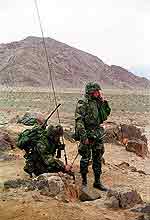 All is not quite as straightforward as it might at first seem. Remember I said earlier that the MoD have now largely vacated this band, well the fact is that there are still around 100 MoD frequency assignments (approximately half of them in Northern Ireland). Details of what and where these assignments are will be accessible to succesful bidders via a software tool that disguises the actual location of usage (for security reasons of course). Further, there are a handful of channels which are used, nationwide, by the MoD. Unless these assignments fall at the very edges of the band (unlikely), there would be insufficient spectrum to deploy cdma2000 which requires a clear block of about 1.5 MHz in order to function. When quizzed about this apparent contradiction to Ofcom's technology neutral stance, Graham Louth responded, "You are misconstruing what we mean by technology neutral". Is that so? cdma2000 can be deployed if you want to, but practically speaking it's impossible to do so. That's like saying, "You can cover this land I'm selling with a building as large as you like, however you mustn't disturb the herb gardens which I've scattered right across it. Oh, by the way, I'm not going to tell you where the herb gardens are until you buy the land".
All is not quite as straightforward as it might at first seem. Remember I said earlier that the MoD have now largely vacated this band, well the fact is that there are still around 100 MoD frequency assignments (approximately half of them in Northern Ireland). Details of what and where these assignments are will be accessible to succesful bidders via a software tool that disguises the actual location of usage (for security reasons of course). Further, there are a handful of channels which are used, nationwide, by the MoD. Unless these assignments fall at the very edges of the band (unlikely), there would be insufficient spectrum to deploy cdma2000 which requires a clear block of about 1.5 MHz in order to function. When quizzed about this apparent contradiction to Ofcom's technology neutral stance, Graham Louth responded, "You are misconstruing what we mean by technology neutral". Is that so? cdma2000 can be deployed if you want to, but practically speaking it's impossible to do so. That's like saying, "You can cover this land I'm selling with a building as large as you like, however you mustn't disturb the herb gardens which I've scattered right across it. Oh, by the way, I'm not going to tell you where the herb gardens are until you buy the land".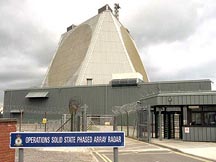 If that's not bad enough, the RAF Ballistic Missile Early Warning System (BMEWS) radar at Fylingdales in North Yorkshire uses the frequencies from 420 to 450 MHz and so the 422 - 424 MHz block can not be used within the vacinity of this station. The radar, which uses high powered radio transmissions to track incoming missiles, is also likely to cause severe interference over a wide swathe of Northern England. So now as well as the herb gardens, we've got industrial chimneys spewing out pollution over large areas of the land for sale. How come the chimneys don't already pollute the herb gardens, well they're owned by the same person of course - the MoD!
If that's not bad enough, the RAF Ballistic Missile Early Warning System (BMEWS) radar at Fylingdales in North Yorkshire uses the frequencies from 420 to 450 MHz and so the 422 - 424 MHz block can not be used within the vacinity of this station. The radar, which uses high powered radio transmissions to track incoming missiles, is also likely to cause severe interference over a wide swathe of Northern England. So now as well as the herb gardens, we've got industrial chimneys spewing out pollution over large areas of the land for sale. How come the chimneys don't already pollute the herb gardens, well they're owned by the same person of course - the MoD!Most likely someone will want to buy this spectrum; an auction for the same spectrum in the Republic of Ireland raised Euro215,007 for the Irish Government. However with so many holes and so much pollution in it, it will be interesting to see how much, or how little, the auction raises. I'll let you know.
add comment
( 2224 views )
| permalink
| 



 ( 3 / 8539 )
( 3 / 8539 )




 ( 3 / 8539 )
( 3 / 8539 )
Wednesday 15 February, 2006, 13:26 - Radio Randomness
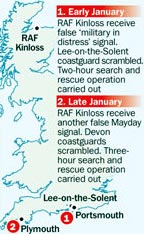 I read an article in The Times newspaper yesterday entitled 'Coastguard scrambled as set-top box sends SOS'. It would appear that, on two separate occasions, radio emissions from a Freeview set-top box had raised an alert with the coastguard who had sent search and rescue helicopters out to find the source, apparently costing GBP20,000 or so on each occasion (special 'centrifrugal' helicopter fuel is very expensive you see).
I read an article in The Times newspaper yesterday entitled 'Coastguard scrambled as set-top box sends SOS'. It would appear that, on two separate occasions, radio emissions from a Freeview set-top box had raised an alert with the coastguard who had sent search and rescue helicopters out to find the source, apparently costing GBP20,000 or so on each occasion (special 'centrifrugal' helicopter fuel is very expensive you see).The alert concerned was simply a transmission on a frequency of 121.5 MHz, one of the internationally recognised distress frequencies. Devices called Emergency Position-Indicating Rescue Beacons (EPIRBs) use this, and other frequencies (406.1 MHz for civil and 243.0 MHz for military emergencies) to alert an international network of Search and Rescue satellites (SAR-SATs) when a vessel is in distress. The various satellites which monitor this frequency can pin-point to within an accuracy of about 20km, the location of any transmission, over an area comprising about 60% of the surface of the earth. The unintentional radiation from the set-top box would therefore have triggered the satellites (which believed it was a distress beacon) to alert ground stations to the signal. The fact that the set-top box concerned was located in Plymouth, a busy naval town as opposed to in the middle of the English countryside would have further alarmed the coastguard (as boats in distress surrounded by miles of farmland would be rather suspicious).
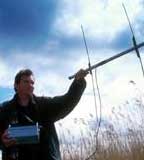 The story continues to say that officials tracked down the source of the interference and knocked, antennas in hand, on the door of the poor unsuspecting lady whose box was at fault. She clearly thought she had been tracked down for television licence evasion, though why she would think this if she had a licence is rather confusing. Obviously the signals were strong enough to merit intervention from the authorities, who took the action of tracking and closing down the problem rather than allowing it to continue.
The story continues to say that officials tracked down the source of the interference and knocked, antennas in hand, on the door of the poor unsuspecting lady whose box was at fault. She clearly thought she had been tracked down for television licence evasion, though why she would think this if she had a licence is rather confusing. Obviously the signals were strong enough to merit intervention from the authorities, who took the action of tracking and closing down the problem rather than allowing it to continue.Two things are surprising about this story. Firstly, the fact that the transmissions from the set-top box were strong enough to raise the alert with the satellite network. EPIRBs operating on 121.5 MHz typically use a power of 50mW or more. The malfunction of the set-top box must have caused some device within the box to oscillate and these oscillations were then radiated back through the TV antenna or the down-lead. To get a 50mW signal in such circumstances, however, is pretty good going. Even a well designed VHF oscillator would struggle to provide a stable 50mW of power on a fixed frequency without drifting as the oscillator got warmer or cooler. And given the poor performance of the antenna at these frequencies, it is likely that the power generated by the set-top box would need to be significantly more than this. It is no surprise that a ground-based search was also able to track down the signal!
 It is worrying in many ways that this is the case. Had the transmission been on a different frequency (for example 121.9 MHz) it would have interfered with air-traffic control (in this case at Heathrow airport). Such events do regularly occur, however there are no satellites that can pin-point the location of the transmission and many go unchecked.
It is worrying in many ways that this is the case. Had the transmission been on a different frequency (for example 121.9 MHz) it would have interfered with air-traffic control (in this case at Heathrow airport). Such events do regularly occur, however there are no satellites that can pin-point the location of the transmission and many go unchecked. The second thing which is surprising is that the box could produce such radiations in the first place. All electronic equipment has to conform to a set of standards known (in Europe) as the EMC directive. This requires all manufacturers to certify that their equipment does not suffer when in the presence of nearby radio transmissions AND that it does not cause unintentional radiation. The set-top box would have had to conform to this standard and thus should have been checked for emissions. Clearly, in this case, the set-top box was malfunctioning, which means that the tests conducted by manufacturers are not extensive enough to capture the results of fault conditions. Does that mean that I could produce a toaster which, if held upside down radiated a couple of Watts in the FM band and claim it conformed when used normally, to toast bread?
What's most worrying is that there are probably hundreds more cases of such radiation which go on unnoticed. In one respect the fact that they are unnoticed means that they are not causing anyone any problems. On the other, it does question whether opening up the use of the radio spectrum in a less controlled manner would really cause the mass devastation that many people seem to think it would.
Friday 3 February, 2006, 18:32 - Much Ado About Nothing
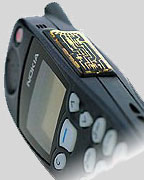 My attention was recently drawn to a product called the 'Power Strip Antenna Booster' (though I believe these devices first came to fame in the USA in about 2001). It was being offered for only 1 pence by a mobile retailer (I won't embarrass them by naming First Phone Shop, oops...) if bought in conjunction with other cellular products worth more than GBP12.
My attention was recently drawn to a product called the 'Power Strip Antenna Booster' (though I believe these devices first came to fame in the USA in about 2001). It was being offered for only 1 pence by a mobile retailer (I won't embarrass them by naming First Phone Shop, oops...) if bought in conjunction with other cellular products worth more than GBP12.The claims being made for this amazing device are quite impressive, "It dramatically reduces static and increases reception by up to 50%", and "It's like having a FIVE foot antenna on your phone". But what I particularly enjoyed were the descriptions of how the device functioned...
"It is a passive device designed to capture the stray radiation inside the body of the phone and re-direct the signal to improve the phone's performance."
"The Signal Booster captures stray static electricity around your phone and focuses it back to the signal, dramatically improving reception."
"It creates a megnetic [sic] field around the handset and draws in more signal also giving better clarity."
To most people these explanations might seem perfectly plausible. As someone who has handled radio for many years, its utter bunkum. 'Focusing stray static electricity back into the signal' makes about as much sense as 'Gathering stray exhaust fumes and channelling them back into the steering wheel'. Surely the fact that the device can be stuck anywhere on the phone, particularly inside the battery compartment, must at least have raised doubts in some people's minds. How can signals get out better if they are trapped behind the battery?
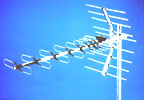 There are devices which can 'focus radio signals, increasing reception quality'. These magical devices are known as aerials (or antennas to our North American cousins). However, there is already an antenna inside every cellular phone, otherwise it wouldn't receive any signal at all!
There are devices which can 'focus radio signals, increasing reception quality'. These magical devices are known as aerials (or antennas to our North American cousins). However, there is already an antenna inside every cellular phone, otherwise it wouldn't receive any signal at all!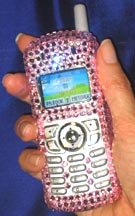 There are a number of devices around which genuinely try to improve upon the performance of these in-built antennas, however the resulting product looks remarkably like... an aerial. A 'patch' that focuses stray radiation, what will they think of next?
There are a number of devices around which genuinely try to improve upon the performance of these in-built antennas, however the resulting product looks remarkably like... an aerial. A 'patch' that focuses stray radiation, what will they think of next?Incidentally, having said all this, I do have a supply of Radio Atomising Crystals. Sprinkling these crystals around your phone, particularly under the key-pad and in that hole where the SIM-card fits has the effect of absorbing nearby interference channels, dispersing weak signals and leaving stronger signals to be more easily filtered by the phone's in-built diplexing separator. These crystals are guaranteed to deliver a massive increase in my wealth and are available for only GBP19.99 for a 5 gram sachet from all bad retailers and some rather gullible good ones who got taken inů
Thursday 2 February, 2006, 21:28 - Radio Randomness
 No doubt a lot of people received cordless phones in their Christmas stocking, not least because with cellular phones all the fashion, it seems rather restrictive to have to use a fixed phone at home. Cordless phones come in many flavours, but in particular come in analogue and digital varieties. It's not always that simple to identify, however, which phone is which. In the radio sense, an analogue phone is one which uses analogue modulation (usually FM) to carry the audio to and from the phone. Conversely, a digital phone is one which uses digital modulation. However some unscrupulous retailers who believe that the 'digital' tag is something which sells, often call phones with digital answerphones (i.e. that record messages digitally) as 'digital cordless phones' - they aren't!
No doubt a lot of people received cordless phones in their Christmas stocking, not least because with cellular phones all the fashion, it seems rather restrictive to have to use a fixed phone at home. Cordless phones come in many flavours, but in particular come in analogue and digital varieties. It's not always that simple to identify, however, which phone is which. In the radio sense, an analogue phone is one which uses analogue modulation (usually FM) to carry the audio to and from the phone. Conversely, a digital phone is one which uses digital modulation. However some unscrupulous retailers who believe that the 'digital' tag is something which sells, often call phones with digital answerphones (i.e. that record messages digitally) as 'digital cordless phones' - they aren't!Why does all this matter? Well, only true digital phones offer any level of security over eavesdropping on your calls. Analogue phones are as very easy to tune into (more of which later...) I know of people who have bought 'digital cordless phones' in the belief that their calls were secure. A brief demonstration using a portable receiver as to how easy it is to overhear their calls sent them rushing back to the retailer from who they purchased the phone. Would the retailer swap it for a proper digital phone - not without them paying an additional fee (It's true to say that true digital phones still command a slight margin over analogue phones).
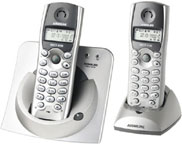 So how do you know whether the cordless phone you have is digital or not? Well, firstly if it is clearly marked as a 'DECT' phone (usually shown as the letters 'DECT', standing for Digital Enhanced Cordless Telephony, inside an oval shaped blob) then you're fine. As well as being digital, DECT, a European standard, normally operates at frequencies between 1880 and 1900 MHz which means that signals don't tend to travel far outside the house. There is an equivalent American DECT standard known as DCT-U and alternative American digital standards, all operating around 900 MHz.
So how do you know whether the cordless phone you have is digital or not? Well, firstly if it is clearly marked as a 'DECT' phone (usually shown as the letters 'DECT', standing for Digital Enhanced Cordless Telephony, inside an oval shaped blob) then you're fine. As well as being digital, DECT, a European standard, normally operates at frequencies between 1880 and 1900 MHz which means that signals don't tend to travel far outside the house. There is an equivalent American DECT standard known as DCT-U and alternative American digital standards, all operating around 900 MHz.For a practical test, try holding your phone next to an electrically noisy device such as a food blender, electric drill or lift/elevator motor. If you can hear crackles or whooshes over the top of your call, chances are you are using an analogue phone.
In the UK, there are three bands in which analogue cordless telephones, termed CT0 - cordless telephony 0 - to represent the '0th' generation of technology - can legally operate (phones imported from other European countries or outside Europe may operate in different bands).
The first of these bands, specified in UK standard MPT 1322 has a base transmitter on frequencies between 1.642 and 1.782 MHz, just off the end of the medium-wave broadcast band, paired with handset transmitters on frequencies between 47.44375 and 47.54375 MHz with a maximum radiated power of 10mW (erp). They can be identified as the base unit has a wire, up to 3 metres long, which trails out of the back. Using such a low frequency, the base transmitters can radiate over quite some distance. These phones are being phased out in preference to the band identified below, but a tune over the lower frequency band will usually yield a number of units still in operation. The handsets, being low power and with small antennas, tend not to radiate over such a wide area.
In 1996 the Radiocommunications Agency, then responsible for managing the radio spectrum in the UK, realised the need for additional channels for analogue cordless telephony to relieve the congestion that was occuring in the existing bands. A further 8 channels were released (specification MPT 1384) with base units transmitting in the range 31.0375 to 31.2125 MHz, and handsets in the range 39.9375 to 40.1125 MHz again at a power of 10mW (erp). Ranges for the base transmitters vary but can extend to over a km.
 One final range of frequencies is used for long range cordless phones (complying with UK standard MPT 1371) with only two channels available and a maximum radiated power of 100mW (erp). Base units transmit on either 47.43125 or 47.41875 MHz and handsets on 77.5125 or 77.5500 MHz.
One final range of frequencies is used for long range cordless phones (complying with UK standard MPT 1371) with only two channels available and a maximum radiated power of 100mW (erp). Base units transmit on either 47.43125 or 47.41875 MHz and handsets on 77.5125 or 77.5500 MHz.If you have a receiver that tunes across the range of frequencies used by these analogue phones, particularly those used by the base units, have a listen (though obviously I haven't told you to do this as doing so would force you to break the law and I can't possibly condone that kind of thing). It's amazing what range 10mW can give at some of these frequencies. Far be it for me to suggest that you could make a game out of guessing which of your neighbours regularly visits a 'medium', or which one's son has just come out as or which has insurmountable debts or ...! And remember, if you buy a cordless phone for yourself, make sure it's digital!

